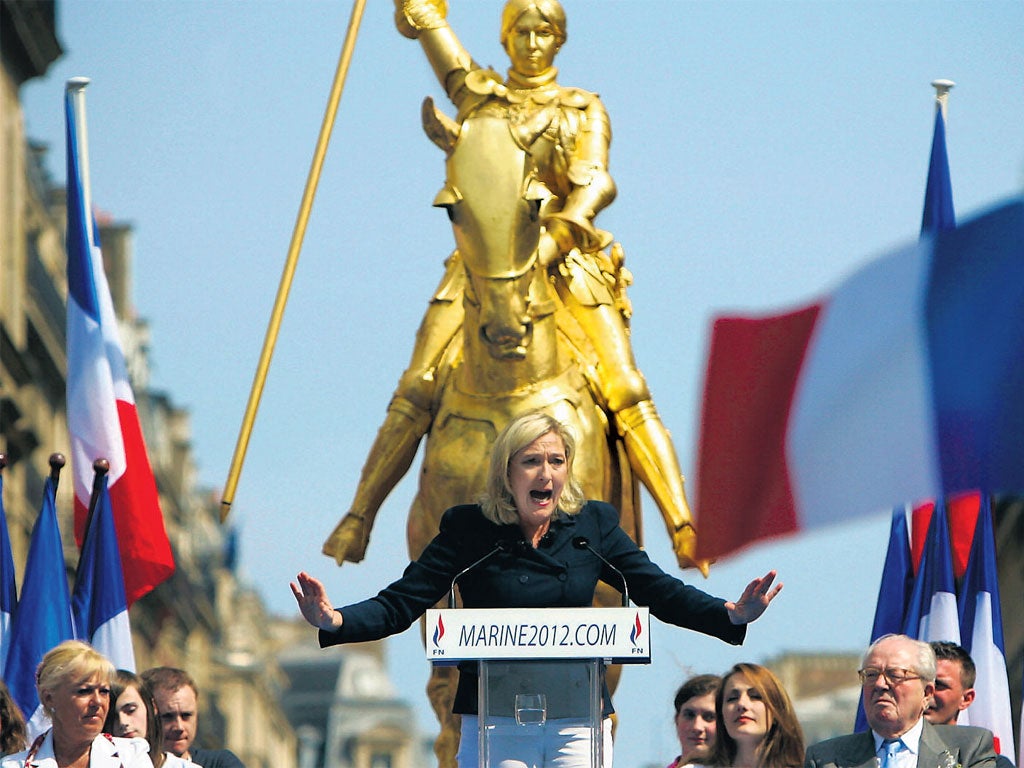Sarko's battle with the Right for St Joan
600 years after her birth, the Maid of Orléans is still a polarising figure, writes John Lichfield

Almost six centuries after she was burnt by the English, President Nicolas Sarkozy will lead a commando operation tomorrow to free Joan of Arc from captivity – not from the clutches of the English, but from her status as the foreigner-bashing heroine of the French far right.
Friday marks the 600th anniversary of Joan's birth. Mr Sarkozy will take time out from rescuing the euro to attend events in her native village of Domrémy-la-Pucelle in the Vosges. He will also visit Vaucouleurs in Meuse, where Joan or Jeanne or Jehanne (1412-1431) spent the early part of her brief career as a religious visionary and resistance leader.
The xenophobic National Front, which adopted her as an icon of ultra-nationalism two decades ago, will also celebrate with a rally led by its leader Marine Le Pen and founder, Jean-Marie Le Pen, in Paris on Saturday.
Mr Sarkozy first tried to wrestle Joan from the far right during his election bid in 2007. While not yet a declared candidate, his appearances tomorrow will mark his entry into this spring's presidential campaign.
Implicitly or explicitly, the President will, like Joan, pose as the saviour of a French way of life menaced by arrogant external forces and internal division. He will imply that he, not the NF, is the true guarantor of French nationhood.
There is nothing new in posthumous attempts to recruit Joan of Arc to political or religious causes. She was virtually forgotten by the French, until her reinvention as a patriotic republican and then as a religious-conservative heroine in the mid-19th century.
In the US and Canada, she has become a feminist icon; in Latin America she is claimed by the revolutionary left as one of the first popular, resistance leaders; and in 1920, she was canonised by Rome as part of a push by the French church to recapture France from godless republicanism.
But who was the real Jeanne? The story is well known. A peasant girl who came from nowhere, directed by "voices" of saints, to lead the French armies and defeat the English. She lifted the siege of Orléans; created a sense of French nationhood; changed the course of the Hundred Years War; but was betrayed by French traitors and burnt by the English as a heretic and a witch.
The problem is that, according to recent French studies, little of that is true. Jeanne never really led the French armies. She was a kind of mascot in armour. She was repudiated by the French king and ended as a guerrilla leader. Her military career lasted just over a year. The Hundred Years War continued long after her death. In any case, her enemies were also French and Burgundian.
Joan was sent by the Dauphin, later King Charles VII, to relieve Orléans in 1429, as part of a food convoy. She galvanised the city's defenders, who were under no real threat from a relatively small attacking force. They assaulted a few English outposts and the English army retreated. She played no great part in the skirmishes but became a heroine for Charles's previously demoralised forces. Charles was anointed king and then, on Jeanne's urging, marched on pro-English Paris but was routed.
Charles rejected Jeanne's zeal to "boot out the English" and sought diplomatic solutions. Disgusted, she fought a brief guerrilla war with her devotees until being captured by the Burgundians outside Compiègne in 1430.
King Charles ungratefully refused to ransom her. The English paid £10,000 and handed her to the church, which disapproved of peasant girls who spoke to saints. After a trial in Rouen, she was condemned for heresy and witchcraft (partly for having worn male clothes). She recanted to avoid the stake but, days later, was "found" in her cell dressed as a man. For having "relapsed", she was burnt alive.
Joan herself claimed that her women's clothes had been removed and she had to dress as a man or go naked. This was probably a medieval sting, conducted by elements in the French church and the University of Paris.
The legend of Joan helped to solidify the "French forces" after her death. Thus she did play some part in booting the English out of France. Her second, posthumous trial, which cleared her in 1456, was a symbol of the post-war creation of a first, true sense of French national identity. Transcripts of her trials mean that her personality has survived: calm, obstinate, driven but not really the voice of a fanatic.
She was plainly a creature of a time in which people saw omens all around them. She is also oddly modern and has inspired writers from George Bernard Shaw to Bertolt Brecht because of the strength she showed in standing up to her malevolent inquisitors.
It is possible to dismiss Joan as a medieval fanatic. It is also possible to see in her the stirrings of belief in the individual conscience. To make her a heroine for xenophobes is to diminish her. To recruit her, 600 years on, to a struggling President's re-election campaign is ridiculous. She belongs to all of us.
Subscribe to Independent Premium to bookmark this article
Want to bookmark your favourite articles and stories to read or reference later? Start your Independent Premium subscription today.

Join our commenting forum
Join thought-provoking conversations, follow other Independent readers and see their replies